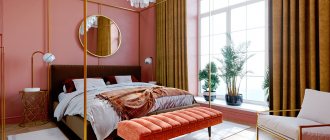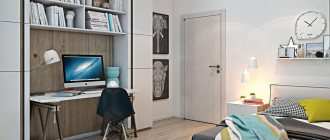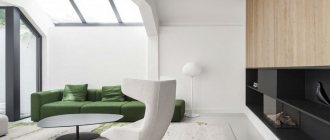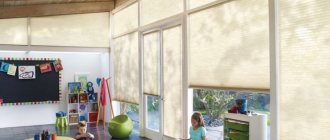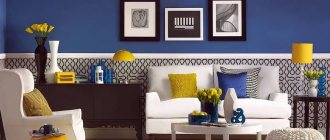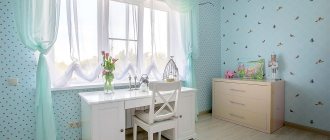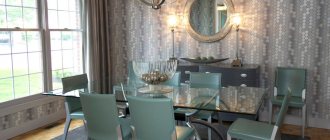In this article we will deal with a small children's room: how to make it comfortable and beautiful for a child, we will show interesting photo examples of design, and also tell you how to organize storage and arrange furniture.
If you allow a schoolchild to create the interior of his room himself, it suddenly turns out that the child really needs free space. Children need their own cozy space - for meeting with friends, for active games and relaxation.
Let's say more - already before school the independent life of a little man begins, he begins to desire to create his own order in his personal area.
Therefore, in the child’s first room there should be a feeling of freedom, and, preferably, an intimate corner and area for joint games.
Even if the children's room is small, you can pass the parental exam and make it exactly as comfortable as possible for the baby.
Let's start with what colors and furniture design techniques we need.
General rules for designing a small children's interior
• For small rooms, pastel basic colors are selected. In a small nursery, pleasant shades of light colors should prevail, reminiscent of summer and warmth - light green, coral, beige.
• Since the furnishings will be updated, the games area will become a work corner; monochromatic wall decoration is encouraged. An interior designed in one pastel tone will look freer. But at the same time, the room should have bright details in the spirit of pop art, appropriate to the child’s age - striped curtains, colored pillows, posters or photo collages.
• A narrow room will be visually expanded by contrasting wallpaper. In this case, the back wall should be highlighted with a brighter color than the rest, or with an interesting small print.
• If the room is long and tall, the accent wall can be decorated with horizontal stripes. They will make the space freer and more harmonious.
• Horizontal stripes on the floor will also expand the walls. And the same effect of lines can be used in the furnishings of the room. In a long room, along a narrow wall you can place a bed, a table or a low chest of drawers with horizontal shelves.
• In general, try to use compact furniture that saves maximum space instead of classic furniture walls. The cabinets in the small play area will be replaced by hanging shelves and open shelving, and the role of a chest of drawers will be played by hidden storage systems.
• And one more important point: both in the bedroom and in the child’s work area there must be good lighting. Diffused soft light slightly expands the walls and will be useful for children's vision.
Therefore, to decorate the window, use tulle, translucent curtains or light-diffusing roller shutters, without a darkening effect.
Lamps located on the ceiling near the walls of a small room will maintain a feeling of spaciousness in the evening.
And most importantly: when choosing a general color scheme, curtains and fancy lamps, remember that boys and girls have different ideas about a cozy fairy-tale room.
Already in children's games, a boy shows the instinct of a conqueror and a hunter, and girls show a love of home comfort, beauty, and dreams of luxury.
Therefore, let’s say in more detail what should be in the men’s and women’s nurseries, and in the room in which more than one child will live.
How to effectively arrange furniture?
There is no optimal option for arranging furniture, however, given the small area, many designers advise placing pieces of furniture as close to the walls as possible.
Provide a combination of open and closed storage shelves.
Even if your baby is still very small, be sure to organize a small workspace. At the table he will be able to perform various creative tasks: draw, sculpt from plasticine, assemble a mosaic, etc. You can make such a table with your own hands using our master class.
If the nursery has an unusual shape, try to use the space taking into account the existing geometry. A specialist in the manufacture of custom furniture or an interior designer can help with proper planning.
A bed combined with a wardrobe combines two functional areas at once, allowing you to free up usable space.
Corner option for placing beds in a small room. This layout saves space in the common nursery.
Small room for a boy: what you can come up with
The ideal room in the dreams of the smallest conqueror may resemble the deck of a pirate ship or an observatory.
The interior of a little boy's room can be made a little fantastic, but most importantly - practical, so that the same fairy tale does not get boring as he grows up.
Let's start with the fact that for a small explorer's abode, the color scheme of Marina and Colonial styles is suitable. Successful examples of basic marine combinations: white and blue, sand and turquoise, light green with brown and blue accents.
This style will be complemented by striped prints and colonial furnishings, from “fairytale wanderings” - a chest or an unusual floor lamp.
Finishing requirements
All materials for finishing and arranging the nursery must be environmentally friendly and not emit harmful substances or strong odors.
- Walls. For smooth walls, a special water-based paint is suitable, which adheres well and dries quickly. As your child gets older, you can repaint the walls over the old paint and change the style of the room. You can use paper or non-woven wallpaper that will hide the unevenness of the walls.
- Flooring. A laminate with a slight roughness is suitable for the floor so that the child does not slip. Cork flooring, which is very warm and non-slip, is also a good choice. It is better to abandon massive carpets and rugs as dust storage; a small carpet made from natural materials will do. If you choose linoleum for a nursery, it should be without synthetic materials.
- Ceiling. Whitewashing or painting will do; you can make a suspended single-level glossy ceiling that reflects light and further enlarges the small area.
The photo shows a white nursery with a red and blue accent on the wall and in textiles. A small room looks wider due to the mirror.
Small room for a girl: how to create comfort
There is a stereotype that a little girl's dream room is always pink, filled with dolls, ribbons and beads.
In fact, even for a little girl, harmony, order and free space are important, in which she is the queen. The basic colors of the interior should match her temperament, and dolls and other accessories should harmoniously decorate the environment, but not take away her personal space.
Suitable colors and combinations for women's nursery:
- white
- coral
- pale lavender
- citric
- orange
- light green or mint
- combinations in the romantic style: gray with pink, gray with blue, beige with brown.
Dreamy girls like not only the colors, but also the general details of the French romanticism style - the canopy, paintings and figured decor.
Such details are especially appropriate when the baby’s taste and self-esteem are developing, and the need for personal space arises. But let us remind you that all interior items should be appropriate and not take up much space.
Small room for two: how to divide the space
In a children's room, even a small and compressed one, there must be several separate zones. If there are two children, it is fundamentally important to delimit the area. In particular, it is necessary to separate the following zones:
• a work corner for a child who is already studying or for joint creativity
• intimate resting places for each of the children.
Therefore, the first important point in the setting of a shared small nursery: try to choose ergonomic furniture in order to provide each child with personal space. For example, there are the following options:
- bunk bed
- sliding double desk
- transparent shelving that will visually delimit the area.
The second point in creating such an interior: you can highlight the territory of each child using contrasting wall decoration and light.
Even thanks to conventional boundaries, each of the children will grow up with the feeling that he has his own corner and feel comfortable in a shared room.
We will offer several options on how to decorate the walls in this situation.
1) Contrasting colors.
This option is convenient, for example, if the room is intended for a boy and a girl or two girls with different temperaments. One part of the room can be noticeably bright, while the other has a calm or neutral color scheme. Examples of harmonious combinations for a small room: pink and gray, pink and orange, blue and white, lavender and cream.
2) Inversion.
In this case, two base colors are used. Each half of the room is dominated by its own color and accents of the color used for the other half.
3) One wall is slate.
This idea will help out when a schoolchild and a baby need to get along nearby.
The achromatic and delicate colors of the finish are pleasing to the eyes of an infant: gray-pink, gray-blue, beige, olive. Plus his children's area can have simple small prints.
An adult child loves a dynamic and vibrant environment, ideal for creativity and active play.
Therefore, for an older preschooler or schoolchild, you can make a neutral gray wall for drawings, which he will decorate according to his own taste.
Zoning the space
In order to fill a room with furniture most efficiently, you should wisely divide the space into zones. The main functional parts are:
- Game corner.
- Work corner (study area).
- Corner for rest and sleep.
- Storage area - for school accessories and other things. If there is enough space, it is better not to combine these functional parts.
- Place for sports. The Swedish wall is an ideal option that does not take up much space. You can also give preference to removable rings and a horizontal bar, which are usually installed in the doorway.
Real examples of effective organization of space can be seen in our selection of successful interiors of rooms of 12 square meters. meters for boys.
Despite the different functions of the main zones, all parts should coexist harmoniously in a single space, without causing visual discomfort and a feeling of cluttering of furniture in a miniature room. By the way, you can see some tips and secrets in our article on planning a 10 square meter nursery.
Modern design for your baby should be dynamic. Ideally, it is possible to change some interior details as it grows older.
Advice: to ensure that the sleeping place provides your baby with maximum comfort, purchase a high-quality mattress with orthopedic properties.
On the desktop it is necessary to take into account space for a computer, as well as full free space for doing homework. It is better to choose a sofa or bed model with special drawers for storage.
When planning the interior, ask about your child’s preferences. Offer him several options, among which he can choose himself. Your child’s character should be felt in the interior - this is the only way he will be truly comfortable here.
A good option for a small area is to use part of the window sill under a desktop. When choosing this idea, think about the design of the window, because textiles should not interfere with the child during classes. The wall near the window can be filled with shelves and drawers, making this part a storage space.
Advice: with this layout it is necessary to exclude the possibility of drafts, so install a reliable double-glazed window.
Try to place the desk near a window so your child can do schoolwork in natural light.
Tip: choose a chair model with the ability to adjust the seat height depending on the child’s height.
This bed design combines a sleeping place and a sofa on which you can accommodate guests or play. Two-tier furniture allows you to combine several functional areas in one area.
Furniture for a small nursery: rely on mobile modules
At the age when a child is ready to separate from adults into his own abode, he needs his own minimum set of furniture. Some headsets are impossible to refuse, even if the room is very cramped. Plus, if there are two children, each still needs something of their own - drawers and shelves for storing toys, personal diaries, textbooks.
But the obligatory classic furnishings can be replaced with more miniature modular items.
- separate bed or ottoman
- desks and hanging racks
- wardrobe, chest of drawers, additional cabinets for clothes and toys.
The role of a separate working corner will be performed by modules with a table top. For example…
- Loft bed. This model is often sold complete with a table, which is compactly located under the bed. — Rack with folding table.
A modern alternative to large chests of drawers are open wall shelves that retain a feeling of freedom, and cabinets-compartments.
The compatible furniture modules are ideal for a small nursery in different respects:
- They are usually very roomy and take up minimal space
- they are easy to move
- and therefore with their help you can easily zone the area
- open modular shelves without glass are the safest
- Modules without sharp corners can be selected especially for mobile owners.
Any headset for a child should be chosen based on these criteria.
On top of that, impeccable furniture is one that meets the requirements of pediatricians and psychologists:
- made entirely of environmentally friendly materials
- with strong fastenings
- has reliable and non-sharp fittings (or without handles)
- moderately bright, in a pleasant color scheme
- fits harmoniously in the room, leaving maximum space for entertainment and relaxation.
Let's say a little more detail about the last point.
Textile
The decorative elements are original curtains or a bedspread, designed in the general style of interior design.
Furniture for a children's room should be safe, durable and compact.
Window design should not disturb the spatial balance of a child's room with a small area. This requirement is met by simple curtains, without draperies or folds, but with an unusual pattern or design. To protect from direct sunlight, it is better to choose thick, thin fabric. The density due to the thickness of the threads is less suitable.
A good choice is roller blinds and blinds.
For a nursery decorated in bright colors, it is better to choose curtains or drapes that are several shades lighter.
See also: Room design for two boys. What's appropriate in the room?
Principles for placing furniture and decorating a nursery
Some furniture modules made from wood materials are easy to move. But, nevertheless, before ordering furniture you need to think about a convenient arrangement. When designing a small nursery, the principles of ergonomics are especially important.
1) It is best to place the child’s workplace near the window.
2) It is worth using non-functional angles correctly.
For example, if the room is square, with a window on the far wall, the table can be located opposite the window, the bed and wardrobe - near adjacent walls, closer to the corners.
If there are two beds, they can be placed perpendicularly, closer to the corner.
This way you can save free space for outdoor games.
The spaces near the window can also be rationally used for corner shelves and open shelving.
3) In addition to the above, if the room is of a non-standard shape, it can be decorated in an original way with items made specifically for the project. In this case, you can specially order
— sets with figured facades
- built-in niches
- a pouffe bench or a bed for a niche.
4) It is advisable to place small modules with sliding doors near the walls in the narrow part of the room.
5) And finally, let’s remember how stripes allow you to increase space. Horizontal lines “pull apart the walls.” And if in a narrow room the window is on the far short wall, it is better to place low, elongated objects near it - a desk or a bed. The window itself will be harmoniously decorated with horizontal blinds or curtains that create a horizontal line.
If the window is on a long wall, you can place a table and a tall module for books nearby. In this case, long curtains like an hourglass will look beautiful on the window.
In classic sleeping areas, homey and cozy, these vintage curtains are welcome. In a more modern children's play area, other solutions are needed. Therefore, let's talk in more detail about choosing the style of the room.
Choice of colors and materials
The most suitable colors for decorating a nursery are soft pastel colors: light shades of yellow, gray, orange, light pink, light blue, beige combined with light green, lavender, white, etc.
Remember that to decorate the nursery it is necessary to use high-quality and environmentally friendly materials, because your child will spend a lot of time in this room.
Laminate or parquet is perfect for finishing the floor. But the carpet should not be large; it is advisable that it fills only the playing area. This way, less dust will accumulate in the room.
A room in light beige shades with neoclassical furniture design is suitable for teenage children, however, it is better to add color accents here too.
Regardless of the chosen shade of the walls, make the ceiling white so as not to visually reduce the height of the room.
The neutral background of the walls will allow the child to concentrate well on homework.
There are quite a lot of details in this interior that overload a small room, but the white background of the decoration compensates for this feeling.
If the children's windows are oriented in the north direction, choose a warm palette for decoration: this will create a psychologically comfortable and cozy atmosphere in the room.
Storage in a small children's room
The best way to keep a small nursery organized is to create proper storage. You can use baskets, boxes and furniture for this. Moreover, the more closed this storage is, the tidier the space will remain. Here are a few examples to help you understand how to use these ideas in your apartment.
Classic, minimalism, marine theme: which style is suitable for your nursery
Modern style is the first thing that is associated with the newest children's rooms, equipped with compact modular furniture.
Modern style allows you to use only 2-3 harmonious basic contrasting shades and only the necessary items. In such an interior, each item has its own place, and zones are clearly defined. And it is in such a room that the child will learn to maintain order and store the necessary things in designated places.
An excellent backdrop for a modern children's room design is plain walls or wallpaper with a simple geometric print.
Tables, shelving, and storage systems may look a little futuristic and curved, but they must be comfortable.
The style is suitable for children starting from 2-3 years of age (we’ll talk about the style for a baby’s room below). Moreover, unlike adult strict minimalism, “children’s” modern style welcomes bright color blocks. In addition, an adult child’s room can be made more interesting with the help of patchwork elements.
Scandinavian style is a similar style, since it also welcomes minimalism and laconicism.
However, in a Scandinavian interior, the basic tones are close to white - milky, gray-white, with blue. And such a light background is complemented by natural furniture - clear, bleached oak, bright pillows and carpets.
Thanks to the soft and pleasant color palette, the style is ideal for the room of a baby and a younger preschooler. But let's return to what adult children value more.
A loft is one of the trends in modern style, which can be called a “beautifully equipped attic.” The style is truly masculine, but it can also be interestingly played out in the abode of a girl-dreamer.
The loft looks harmonious if the children's room is located in the attic of the house. In this case, you can decorate the plank walls with your favorite children's posters and maintain the atmosphere of an abandoned room (which boys love so much!).
You can create a similar environment in an ordinary small room with large windows.
The main thing in style is a brick or gray wall, mysterious metal lamps, and an abundance of light. All furniture should be functional and maintain free space. The end result should be a practical room, ideal for active games and creating a mini-workshop.
The classic style, on the contrary, offers a set of design techniques for decorating an adult girl’s room.
Such a room can have a monochromatic design (typical of modern projects) or wallpaper with vertical stripes. But the basic colors of the classics are not childish, but more restrained, “royal” - pink, olive, beige. The right shade will expand a small space.
Plus, the monochromatic palette of the classic sleeping area is necessarily decorated with decorations - expensive fittings and curly headboards, an original chandelier, long palace curtains. Textile decorations in the patchwork style and paintings are also welcome.
Provence is another feminine style, harmonious, with elements of French classics.
In a women's room in the spirit of Provence, one very pleasant and always natural color predominates - smoky white, olive, herbal, lavender, and maybe a floral print. Small flowers will make a small room feel more spacious.
At the same time, there are definitely shelves and souvenirs made of wood, forged metal, embroidered pillows and wicker baskets. Such accessories resemble not palace decorations, but homemade gifts, and for this reason alone they may appeal to an adult girl.
In general, Provence resembles the atmosphere of a rich country house, sets the mood for relaxation, and is suitable for the bedroom or lounge area of a young princess.
And finally, another style that can be used in an unusual way in a children’s room is marine.
The style appeals to boys, but satisfies the need of all children for romantic adventures, allows them to constantly play treasure hunters and collect souvenirs.
When creating a style, the following colors are taken in different combinations: white, blue, turquoise, green, some red shades, and details with striped prints. If space is tight, keep the base trim white or with wide stripes.
Textured wooden furniture is very appropriate in this style. And to decorate the room, you can use a steering wheel, a compass clock, souvenir ships, linen curtains, and rope hangers for curtains.
In general, the child will figure out how to fill the room with overseas treasures.
The main thing in any style of a children's room is not chic or creative toys, but convenience and details that correspond to the age and desires of the child. Therefore, look through different interiors and ideas together with the youngest member of the family if you are going to furnish or refurbish his small abode.
General rules and room zoning
In order for a small children's room to look visually larger, you need to follow several rules:
- Light color palette (pastel wallpaper with or without a pattern, glossy white ceiling, do not use more than three colors to create an interior). Bright accents are appropriate for children under 7 years of age and more subdued ones after 9 years of age.
- Choosing vertical shelves and racks, avoiding horizontal cabinets and open shelves (narrow, tall furniture pulls up the entire space, closed doors hide all things and organize order).
- A maximum of functional things, unnecessary accessories along with toys will clutter up the empty space of the nursery. It is important to have drawers and hidden shelves for toys on the windowsill, under the bed or in the corner.
The main rule for zoning a small nursery is to place furniture near the walls to free up as much space as possible.
- The work area should be well lit by daylight and artificial light, so it is better to place the table near the window. A student needs only a small table, a comfortable chair and one small wall shelf. It is better not to choose a wide table (to save space and not to clutter the table with unnecessary items).
- The rest area or bed in the nursery should be illuminated with muted warm light for the child to fully rest; a bedside night light will help the child get used to sleeping on his own.
- The play area may contain boxes with toys, an easel or slate board, a game console and a TV, a small sofa or soft bean bag chair, a floor mat or pillows.
The photo shows the functional use of the space by the window as a relaxation area with separate lighting.

